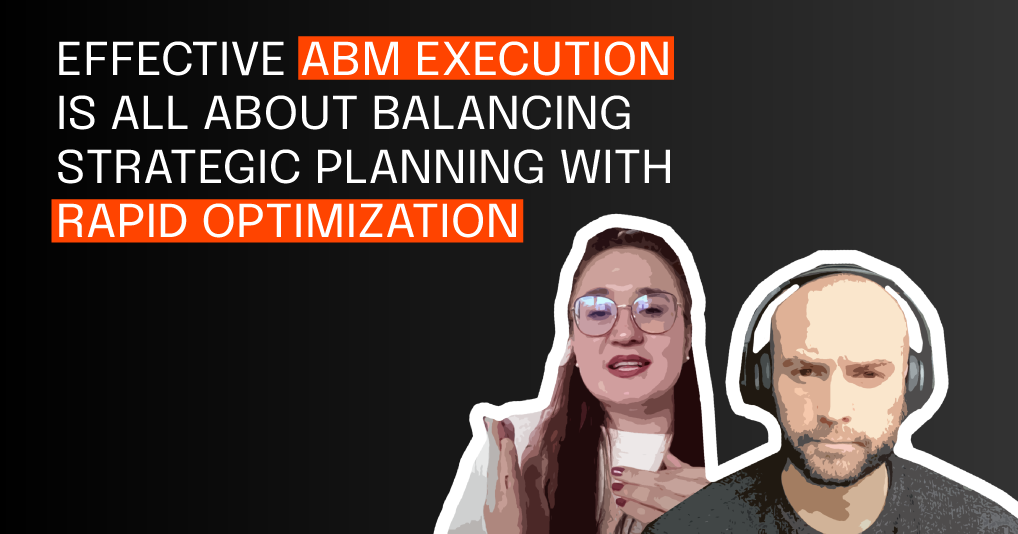Setting objectives for ABM (Part 1)
6 November 2023
Jack Rawlings & Josh Weale ▪︎ Heads of ABM
Success looks different to every organization – which is why defining your ABM objectives is vital. In Part 1 of this two-part episode, Jack and Josh start to dissect what makes a good or bad ABM objective.


Josh is a Head of ABM, leading the development of innovative strategies to help enterprise tech businesses win, grow and retain their most important accounts. With a background in journalism and several years of client-side experience, he works with Sales and Marketing teams to help them succeed.
ABM Lunch and Learn
Fast forward your team's ABM learning and accelerate your growth
We’re on a mission to create great ABMers
Subscribe to our ABM insights and podcast releases.
Why Setting Objectives in ABM Matters
What is a journey without a destination? Some might say an adventure! But realistically, you're just going to get yourself lost. And with ABM, being lost is the last thing you want...
Every journey needs a set destination in order to be successful. Your ABM program is no exception – which is why setting the right objectives is vital. But no two organizations will have the same outcomes in mind. So how do you know what the right objectives are for you?
In Part 1 of this two-part episode, Jack and Josh team up to discuss the intricacies and challenges of setting objectives – from 'North Star' metrics to alignment and the Three Rs.
Read Podcast Transcript
Jack Rawlings (strategicabm) – Welcome back to another episode of ABM Under the Hood. My name is Jack Rawlings, and I'm joined again today by Josh.
Josh Weale (strategicabm) – Hey, Jack. Great to be here.
Defining the “North Star Metric” for ABM
Jack (strategicabm) – Good stuff. So, today we're going to be talking all about objective setting in ABM, and specifically thinking about things like North Star metrics, kind of overarching goals and objectives that you can focus on when you're setting up an ABM program.
Also, kind of, how to prioritize metrics from a business perspective, understanding what a good objective for an ABM program looks like, and what a bad objective for an ABM program looks like, and lots of other stuff that we're going to, kind of, go into today, as well.
But, I guess first of all, Josh, in terms of setting objectives in an ABM program, do you think that it's something that you find businesses are, you know, generally quite good at? Or is it something that, you know, businesses tend to struggle with?

Josh (strategicabm) – Yeah, I think it really depends on the level of maturity in the ABM program. I think a lot of businesses, particularly when we're talking about enterprise-level businesses, they've been doing this for a long time, and it's very ingrained within the business to, kind of, track Marketing metrics – things like MQLs and SQLs, and how do Marketing report back to the Leadership teams to be able to actually say, "This is what we've done, and this is the output."
So, I think in terms of reporting, we do have a very, kind of, well-defined set of methods for how Marketing is traditionally reported. I think the challenge with ABM is that those methods, because we're talking about Sales and Marketing having shared objectives, we obviously have to have a slightly different approach.
So, rather than thinking about MQLs and SQLs, it's thinking more about Marketing Qualified Accounts and Sales Qualified Accounts. So, that needs a whole, kind of, set of considerations when it comes to, how do we set objectives and what do we report on, really.
So yeah, I think it ultimately depends on the level of maturity because it depends, like, how far you need to get to be able to translate what you're currently doing to something that's relevant for an ABM program.
Jack (strategicabm) – Yeah, yeah, absolutely. So, yeah. So, I guess, in terms of North Star metrics then... So, I mean, first of all, how would you define a North Star metric from an ABM perspective? What are we, kind of, talking about when we say that term?
Josh (strategicabm) – Yeah, I think for me, really, North Star metric is, ultimately, what is the outcome that you most desire from your ABM program? And that comes from thinking about where you are, when you start the ABM program, and who you're targeting, and what you want to achieve with them.
Aligning Business Goals & ABM Objectives
I mean, at the Agency, we use a reporting methodology called the Three Rs, which has been around for a very long time, originally coined by Bev Burgess. And we look at Reputation, Relationships and Revenue – and all of the metrics that sit within those. So, there's multiple, kind of, ways of reporting on an ABM program that sit to, kind of, align metrics to that thinking.
But when we're talking about, kind of, a North Star metric, it's kind of the big picture. So, if you are running an existing customer ABM program, it's how many of these customers can we get to spend more money with us? If it's a net new customer acquisition, it's how many of these customers, or how many of these prospects, sorry, can we get to engage with us and purchase from us?
So, ultimately, the North Star metric is, kind of, what the final outcome is. And then along the ways, you have to plot some of these, kind of, smaller milestones. So, what is the most common trigger point to get to there? So, it could be a specific call-to-action, or it could be a specific sequence of events that you know that, if we can do this 10 times, then 8 times out of 10, we're going to have somebody progress through into a more Sales, kind of, led conversation.
So yeah, I think it's kind of quite a broad answer, but it's about understanding, kind of, what is the overall outcome of the ABM program.
Jack (strategicabm) – Yeah, absolutely. I think also, you know, the key thing about North Star metrics is they've got to be set at that business level, right? It's not a Marketing-only goal. And, you know, we talk a lot about Sales and Marketing alignment and wider business alignment. But, you know, essentially the business has to be in complete, kind of, agreement and, you know, aligned on what that goal looks like and understand what the outputs of the ABM program might well be.
And then, the whole business is working towards that North Star. It's not just about Marketing trying to achieve a specific set of, you know, MQLs or whatever it might be. It's about having a broader, kind of, business lens that you can attach to the ABM program.
Josh (strategicabm) – Yeah, I think that's a really good point. And I think it's one of the things that we try to consider when we talk about reporting with our clients, right? Because one of the things that we often get is people want to know how are their campaigns performing. And it's very, kind of, straightforward to say, "Well, Campaign X is doing Y." And we can report on that because we've got impressions, we've got engagement data, we've got all of that platform data that shows us what's happening within a campaign level.
But really, what the business wants to see is, well, what's the business value? What's the value that they're gaining from this activity? So, wherever possible, it's about, kind of, taking that campaign-level data and then wrapping it up and rolling it up into, kind of, that higher-level business value. So, we always recommend, kind of, reporting on multiple levels to reflect that.
Jack (strategicabm) – Yeah, I think, yeah, it's a really good point. So, I mean, I guess from a Marketing perspective then, how would you go about, kind of, making this decision around what that North Star metric should be, or sort of objective, overarching objective, for the campaign for the program? Do you think it's a case of pulling together, you know, ideas based on where the business is at and, kind of, extrapolating from there? Or do you think, you know, there's a need to speak to the wider team first? How would you, kind of, suggest people go about that?
Josh (strategicabm) – Yeah, it is interesting, 'cause you said from the Marketer's perspective there, but what I would actually say is that it's the Marketer's prerogative to have this conversation with the Sales team and to make these decisions in partnership.
Because, as the Marketer, if you go into a room full of Salespeople and say, "We're going to do an ABM program. We're going to try and win net new customers in this segment," and it's the first time Sales have really been involved in that conversation, they're going to turn around and say, "Well, actually we've got our own priorities over here. We're already doing X, Y, and Z. When do you expect us to be able to actually fill in this ABM program as well?"
So, from that perspective, it's really important that from the very outset of you've decided to do ABM, it's about winning, kind of, trust and buy-in with your, kind of, Sales counterpart and actually building the ABM program from the ground up with them involved from the very beginning. So, making those decisions around, kind of, the objectives and what that North Star metric should be, should be very much a joint effort.
So, that's kind of the first place I'd start. But then it's about, kind of, working out where the biggest opportunities are. So, looking at your existing data sets, looking at your existing pipeline, your existing, kind of, customer data, and seeing, well, where have we had the most success in the past? Where is there an opportunity, if there's, like, market trends or if there's, kind of, a big swing into a certain direction of travel within the market. And then making decisions using that existing data.
So, a lot of issues that we see are when, sometimes, you work on an ABM program and it feels a little bit like a decision's been made to target a certain market or a certain group of accounts because it feels, kind of, convenient to do so. When the reality is, it's probably more valuable to actually go and do the thing that's a little bit more difficult, because the size of the opportunity is bigger. So, it's also about measuring up the available resource versus the size of the opportunity, as well.

Jack (strategicabm) – Yeah, that makes a lot of sense. So I mean, how would you think the, kind of, overarching North Star-type objective aligns with different program types? Like, would you say that the different program types are going to naturally lend themselves to different North Star objectives? Or do you think that there should be some kind of North Star objective that almost sits above that delineation, that, kind of, differentiation between program types?
Josh (strategicabm) – Yeah, that's a really good question. I think, ultimately, you have a North Star metric that sits above the account, and that North Star metric for the account is what drives the whole ABM program of what you're trying to achieve.
But underneath that, I can certainly see a way in which you would then break that metric down to be reflective of the market, the account, the stakeholders. And you can actually break that down across each of the ABM types.
So, for a One-to-many program, the North Star metric may be: We need to generate meetings with 60% of these accounts that are in market. At the account level, it may be: We've got a cluster of 15 accounts, and we need to increase our footprint within these accounts by 50%. And likewise, at the stakeholder level, it may just be, kind of, securing a meeting with a particularly elusive stakeholder, or a type of stakeholder that you've not always been able to build bridges with.
So, I think to answer the question, yes, you have a North Star metric that sits above the account, but you can then break it down into those different types of metrics that match the type of ABM program.
Jack (strategicabm) – Yeah, I think that's a good point. You almost want to have something that really encapsulates all of that, kind of, ABM lens and work that you're doing. But at the same time, there needs to be a, kind of, clear picture of the value of what each activity or each program type is also, kind of, bringing to the table, right?
And I think, you know, with a One-to-many program, for example, you are not going to be looking for... You know, your overarching goal isn't necessarily going to be to be generating revenue within six months, or something like that.
Whereas, with a One-to-one program, where you've already got existing relationships with a business, you've already got a conversation started, maybe even you've got an opportunity in the pipeline, you know, yeah, the overarching goal potentially there should be to get them from, you know, that point to revenue and to a deal closed. So, it will change, depending on, you know, where the accounts are at in that journey and in how you're targeting them.
Considering Program Types & Timelines
Josh (strategicabm) – Yeah, exactly. And you make a really good point there about, kind of, timelines for your objectives, as well. One of the biggest mistakes that I see on a regular basis is businesses that have decided, "Right, we're going to do an ABM program," and then six months later, their Leadership teams are asking, kind of, "Where's the results of the ABM program?"
But the reality is, they've got a Sales cycle length of nine months to a year. So, how can you, kind of, go from starting at scratch to winning deals within six months of an ABM program? You'd have to be pretty fortunate or just be in, kind of, the right set of circumstances to be doing that, because it certainly wouldn't be the norm. It would be an exception.
So, it's about being realistic with the business, as well, when you're setting those objectives of, "Right, we've got a Sales cycle of a year. We know that we need to, kind of, secure these certain stakeholder groups, and this is our plan to do that."
Milestones, Leading Indicators & Storytelling
And over time, you'll find ways of optimizing your processes to accelerate the deals-sales cycle. But ultimately, it has to be, kind of, measured against what's the overall length of time that a deal normally takes for us to close, and then breaking it down into, what are those kind of metrics and milestones that we can put in place across the length of the ABM program to see those, kind of, leading indicators about, "If we can do X, Y, and Z, then it's likely to lead us to be able to close this deal."
Jack (strategicabm) – Yeah, I think that leading indicators point is absolutely key, right? Because when businesses – and it usually is the wider business, the Leadership team, you know, sometimes the board or investors – are asking, you know, "Well, how's the ABM program performing? What are the results?"
If you are clear upfront about what to expect at certain milestones and points throughout that program. So, you're going to say, "Right, at month six, we're not going to necessarily be expecting revenue. However, if we've got X number of accounts at this stage in the journey, we've moved them from reputation and awareness to relationships" – that's going to indicate that, from that point, it'll take another three, six months, however long, to get us those first deals coming through and those revenue numbers starting to appear.
You know, so you can almost sort of say to them, "This is the path. And if we're on this path and we're hitting these specific milestones, then we're good, we're fine, we'll be there. It just takes a bit of time and takes a bit of patience to get there. And as long as we're hitting these things on the way, then we're on the right track."

Josh (strategicabm) – Yeah, it's about storytelling. One of the ABMer's biggest, kind of, responsibilities and biggest skills, if you can do it well, is about telling a story. "This is where we are today, and this is where we're going towards, and this is everything that's going to happen in between." If you can bring that to life, it makes everything else a lot easier, because the business can really see the value and see, kind of, the direction of travel for the ABM program.
Jack (strategicabm) – Yeah, yeah, 100%.
___
Jack (strategicabm) – That's the end of Part 1 of our objective setting episode. But the conversation doesn't end there. Join us for Part 2, where we'll be going back under the hood of objective setting to explore everything from indicators of success, to securing alignment on objectives, to the value of transparency, and much more.
Quick recap of Setting in ABM (Part 1): Finding Your North Star
1. North Star metrics align ABM with overall business objectives.
2. Collaboration with Sales is critical for setting realistic goals.
3. Timelines should reflect the length of your sales cycle.
4. Leading indicators help track early progress when revenue isn’t immediate.
Stay Tuned for Part 2
• Look out for our upcoming discussion on alignment strategies, transparency, and indicators of success.
Check out all episodes of ABM under the Hood here.
Make sure your ABM engine is finely tuned. Subscribe to future episodes.
Let's talk
Looking to start your ABM journey or need help with your current program? We'd love to know more.
Here's a simple form to start the conversation
Alternatively - grab a time here to talk
- Follow strategicabm on X
- Follow strategicabm on LinkedIn
- Follow strategicabm on Facebook
- Follow strategicabm on YouTube
- Follow strategicabm on Instagram
© 2026 strategicabm / Strategic ABM Ltd. All Rights Reserved | Privacy
Strategic ABM Ltd is a private limited company registered in England & Wales. Registration number 13082021.
HubSpot Platinum Partner
Google Certified Partner
Nexus Gold Accredited Partner








